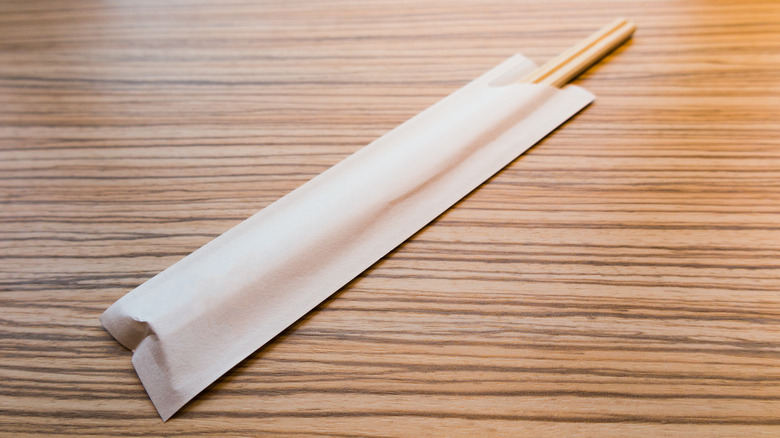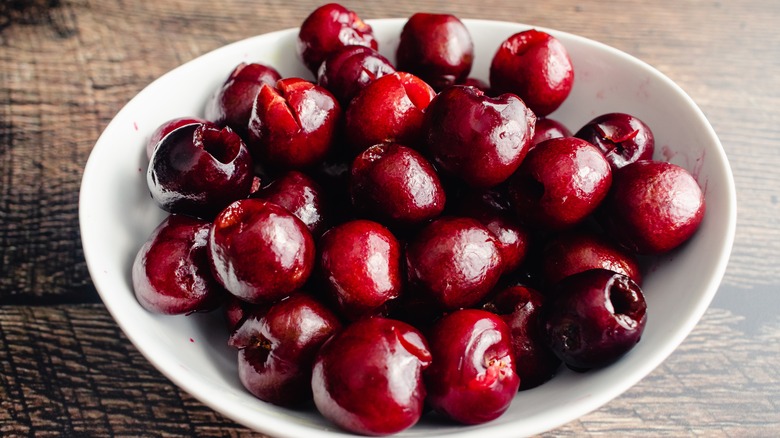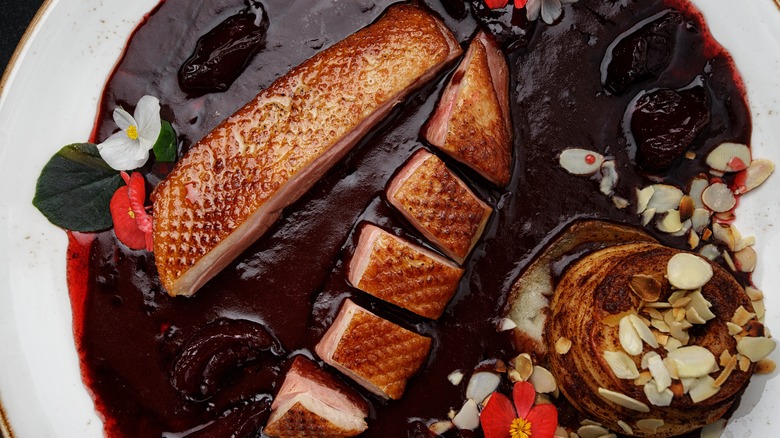Make Your Life Easier And Pit Cherries With A Chopstick
We may receive a commission on purchases made from links.
If you're a fan of Chinese takeout and of saving things for serendipitous later use, MacGyver-style, then chances are you have a kitchen drawer filled with sauce packets and disposable chopsticks. While a squirt of soy sauce might be just the thing you need for your steak marinade between grocery runs, what can you do with all those chopsticks?
History explains that part of chopsticks' takeover of Asian cuisine can be attributed to Confucius, who thought that pointy knives at mealtime evoked unhappy feelings. History adds that the first-ever disposable chopsticks, made of wood or bamboo, were invented in Japan in 1878. Presumably, people have been hanging onto their extra chopsticks ever since.
But fortunately, your pile of takeout chopsticks won't need to wait a few centuries until they fulfill their destiny. You can use them as drink stirrers, popsicle sticks, egg whisks, for leveling measured baking ingredients, or to dry plastic bags you intend to reuse (per Fox News). They also make skewers for spiraling hot dogs, making kebabs, or testing to see if your fish is done — mainly if they're made of metal, like the stainless steel chopsticks popular in Korean cooking (per Food Network). But one of the most unexpected, valuable ways to put chopsticks to use is in pitting cherries.
How to pit cherries with chopsticks
According to MasterClass, begin by putting the cherry on the rim of a narrow-mouthed bottle, small enough for the fruit to stay put. Southern Living explains that you should also take off the cherry stem and situate the cherry with its dimple side facing up so you know where to insert the chopstick. You then push the chopstick through the center of the cherry, allowing the pit to fall conveniently inside the bottle without staining your countertop. Of course, you can get yourself a dedicated cherry pitter, but too many one-use kitchen tools are just clutter. Farmer's Almanac reminds us that this trick also works great with olives.
Why would you need to pit a bunch of cherries? First of all, pitted cherries make for a much better eating experience. You don't need to eat around the pit, maximizing enjoyment and eliminating the need for an unsightly, messy bowl of pits. Cherries are delicious when dried and eaten with wine, cheese, and charcuterie. You can make jam or chutney with them — not to mention countless desserts like Ree Drummond's cherry pie or Food Network's cherry cobbler. On the savory side, you've got Michael Symon's pork steaks with cherry barbecue sauce, Gordon Ramsay's Gressingham duck with Madeira and cherry sauce, and Tom Colicchio's sour cherry bbq wings.
More on cherries
There are two types of cherries: sweet and tart. Kimmel Orchard & Vineyard explains that sweet cherries (like the Bing) are bigger and typically deep red or purple versus vibrant red tart cherries. While both kinds can be eaten straight-up, they say the tart ones usually find their way into baked goods — especially the Montmorency variety. If it doesn't feel worth the work to cook with fresh cherries, you have chopsticks in your corner now.
Tart cherries, in particular, boast some significant health benefits, including unparalleled levels of anti-inflammatory substances. Healthline adds that cherries are high in fiber, vitamin C, and potassium, plus B vitamins, minerals, polyphenols, and antioxidants.
Foodprint says to avoid damaged or softened fruits when purchasing cherries and use them ASAP. They recommend refrigerating them immediately and washing them only before use or freezing them for later. Popular varieties include Washington's sunset-colored Rainier cherry, dark and sour amarena cherries from Italy, and English Morellos. Maraschinos are not their own variety but processed sweet cherries (per The Pioneer Woman). There are even "white" cherries like the Blanca de Provenza. There's a wide world of cherries — open that junk drawer, retrieve a bottle from your recycling bin, clean it up, and start poking around.


